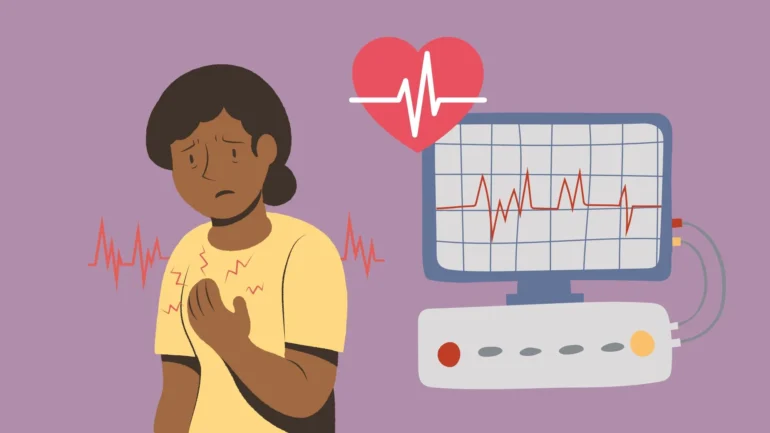There are more and more ways to monitor our heart rates, but what do the numbers really mean? Here is everything you need to know.
Are you sitting comfortably? If so, put out one hand so you’re looking at your palm, then use the first and middle fingers of your other hand to feel for the pulse on the inside of your wrist. Count the beats for 60 seconds, and that’s your heart rate. Assuming you’re resting rather than exercising or stressed, it will probably be somewhere between 60 and 100 beats a minute. But what does it mean if it’s at the top or bottom of the range – or even outside it?
We’ve known about the connection between heart rate and health for thousands of years. Herophilus of Alexandria (325-255 BC), sometimes known as the father of anatomy, designed a water clock to time the pulse, at around the same time that Chinese physicians were using its strength and regularity to diagnose disease. A couple of centuries later, Roman Greek surgeon Galen nudged things along by watching recently deceased gladiators’ hearts beat their last, going on to write: “Exercise to begin with – and so long as it is practised in moderation – renders the pulse vigorous large, quick, and frequent. Large amounts of exercise, which exceed the capacity of the individual, make it small, faint, quick and extremely frequent.” Since then, physicians and scientists have been hard at work on different ways to track our heart rate, as well as the variations within it. What do the measurements actually tell us?
Let’s go back to that resting heart-rate figure of 60-100bpm. “A healthy range can vary depending on factors like age, gender, fitness level and overall health,” says Dr David Culpepper, a family medicine specialist with LifeMD. “Athletes and people who are very fit may have resting heart rates below 60bpm, while babies and young children can often have heart rates above 100bpm, which gradually decrease as they get older.”
If your heart rate is below 60bpm, you may now be congratulating yourself on your athlete-level fitness. But take a beat. Bradycardia – a slower-than-normal heart rate – “can also be caused by issues with the heart’s electrical system, an underactive thyroid, or other medical conditions,” says Culpepper. “Also, some medications – particularly those used to treat high blood pressure and certain heart conditions – can lower heart rate as a side-effect.”
Your lifestyle can also affect your heart rate, usually by raising it. Stimulants can cause dramatic changes. “Caffeine increases the effects of adrenaline on the heart, which means that excessive consumption of tea, coffee, or energy drinks can cause a temporary increase in heart rate – though this effect may decrease over time as your tolerance increases,” says Dr Elijah Behr, a consultant cardiologist at London’s Mayo Clinic. “Nicotine in cigarettes can temporarily increase heart rate and, with prolonged use, contribute to chronic heart and circulatory issues. Alcohol, depending on the individual and the amount consumed, can either increase or decrease the heart rate.” Over the longer term, too much booze can affect the heart muscle, impacting on the heart rate and overall cardiac health.
Emotional states such as stress, anxiety or excitement can cause short-term spikes in heart rate, and chronic stress might contribute to long-term irregularities. But if you’re not under any particular pressure, a fast-beating heart is cause for concern. “If it comes out of the blue, with no apparent reason, then it can be due to an underlying heart condition, and needs to be investigated,” says Behr. “Obviously, the urgency is greater if the heart racing causes dizziness or a blackout.”
What about exercise? As Galen noticed, while you’re actually exercising, your heart rate will increase as your heart pumps blood to your muscles and lungs. A recent meta-analysis of studies confirms that cardiovascular exercise (and yoga) can lower your resting heart rate over time – but there also seem to be benefits to the heart’s health from strength training, though the mechanism is less well understood. Even more relaxed forms of exercise, such as tai chi and qigong, might help.
You may have come across the “finite heartbeat theory”, or the idea that there is a limit to how many times our ticker can tock over our lives, but it’s unlikely to be worth worrying about this: even if it was true that you only had four billion or so beats to play with, the (relatively) small amount of time your heart rate is elevated by exercise should be more than balanced out by it lowering over time.
Exercise can also improve your heart rate recovery (HRR), the rate at which it returns to normal after you stop, by making your circulation and heart itself more efficient. A recent review of studies suggests that HRR is probably a good indicator of overall heart health (just to be clear: faster recovery is better).
There is another figure that scientists are increasingly excited about: heart rate variability (HRV). While your heart rate itself represents an average – it’s the number of times your heart thumps over a given period – HRV reflects the changing pace of those heartbeats, because even if there are 60 of them in a minute, they won’t occur on the second, every second. We’ve known about HRV for a while – Carl Ludwig’s kymograph allowed it to be measured (using a metal drum covered with smoked paper) back in the 1840s – but it’s only with the influx of wearables such as smart watches and fitness trackers that most people can measure it in a way that might be helpful.
The variability itself is caused by the two competing branches of what is known collectively as your autonomic nervous system, comprising the sympathetic, which controls the “fight or flight” responses, and the parasympathetic, which regulates the “rest and digest” functions. The sympathetic system urges your heart to speed up, the parasympathetic tells it to calm down, and the resulting fluctuations form a sort of shorthand for your overall nervous system’s health and capacity to adapt. “Measuring our resting heart rate and HRV first thing in the morning or during the night can provide us with a useful indication of our body’s stress response,” says Dr Marco Altini, an ultra-distance runner, scientist and specialist in heart-rate training. A higher number isn’t always better, he says: “It’s crucial to work out your own optimal range and watch out for times when you go outside it.”

If we’re healthy and coping well with the various sources of stress we are under – physical or psychological – our HRV will quickly re-normalise after exercise. If, on the other hand, something is still off, and we’re under more stress than we can cope with, the following night or morning our heart rate will still be slightly elevated, and our HRV suppressed. If you were planning a big workout – a high-paced run or a heavy gym session, say – this would be your cue to ease off until you’re in better shape.
This possibility of fine-tuning when and how hard we exercise is one reason for the popularity of devices such as the Whoop band and Oura ring, which measure both heart rate and HRV 24 hours a day. But it’s not just about working out.
“We might start to see the negative effect of certain stressors – like our alcohol intake – on our body a bit more clearly,” says Altini, “Or we might be able to spot an upcoming illness a little in advance, allowing us to make better choices for our health and the health of others.” Studies show, for instance, that hydration has a positive effect on both heart rate and HRV, while poor sleep quality has a negative effect. Simply being more aware of these effects could help you to address them.
So if you want to be more aware of what is going on in your body, and how your lifestyle affects it, your heart rate and HRV can be helpful tools. It has never been simpler to measure both of them. But perhaps Prof Andrew Flatt, a specialist in HRV training, should have the last word: “Tracking is useful, insightful, educational and so on – but not necessary,” he says. “Ultimately, correct application of it will guide you to most of the behaviours folks should be doing anyway. You will realise that you should perform daily exercise or be less sedentary, prioritise quality sleep, eat well, quit smoking, limit alcohol, manage stress, foster good relationships and budget periodic downtime. It’s a behaviour modification tool for health – but I wouldn’t say that anyone needs to use it.”
A beginner’s guide to heart-rate training
Many runners “struggle with intensity”, in the words of Dr Beatrice Schaer, a UK Athletics running coach. “They tend to run too hard for what should be their ‘easy’ runs, but don’t work hard enough for what should be their ‘harder’ runs.”
Heart-rate training addresses this by splitting runs into different levels of intensity, or “zones”, based on your maximum heart rate (MHR). Here’s your simple guide to making a start.
1 Work out your max
One common piece of advice is to work out your MHR by plugging your age into a formula – either simply subtracting it from 220, or doing some slightly more complex sums – but this method has its issues (and also tends to misrepresent the maximum heart rate in women). “When it can be done safely, the best way to determine an individual’s maximal heart rate is after a high-intensity effort,” says Altini. A classic example is a 5k run with the last kilometre or so done as fast as you can – your heart rate as you finish should be close to your MHR (note: please don’t do this if you have any health concerns).
2 Train in the zone
Once the hard part’s done, you can make at least some of your workouts easier. Each heart-rate zone corresponds to a certain percentage of your top-end intensity – for instance, if your MHR is 185, you would simply multiply that by 0.5 and 0.6 to find your zone 1 intensity. There are plenty of calculators that will do this online, but many modern wearables will do it for you.
3 Speed up (slowly)
From here, you simply keep your cardio efforts inside the boundaries prescribed by the training plan you’re on: this will typically include lots of efforts in zones 1 and 2 early on, building to intervals or entire workouts in zones 3 and 4 as the weeks go by.


